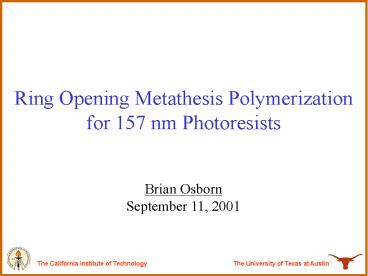Ring Opening Metathesis Polymerization for 157 nm Photoresists - PowerPoint PPT Presentation
Title:
Ring Opening Metathesis Polymerization for 157 nm Photoresists
Description:
Added steric. bulk may restrict. rotation. New comonomers: ... new norbornene monomers with increased steric bulk to make hydrogenated polymer ... – PowerPoint PPT presentation
Number of Views:703
Avg rating:3.0/5.0
Title: Ring Opening Metathesis Polymerization for 157 nm Photoresists
1
Ring Opening Metathesis Polymerization for 157 nm
Photoresists
Brian Osborn September 11, 2001
2
Ring Opening Metathesis Polymerization (ROMP)
- Advantages
- Low catalyst loading (lt 50 ppm), therefore little
residual metal (Ru) - Polymerizes geminally disubstituted norbornenes
- Robust catalyst, functional group and water
tolerant - Molecular weight can be controlled
3
Geminally Disubstituted Norbornenes
- ROMP catalysts easily polymerize key monomers
Free rotation allowed
Problem Tg too low (25-30 C) for norbornenes
4
Routes to High Tg ROMP Polymers
- The 193 nm System Approach
- Incorporation of dinorbornene and carboxylic
acid (-COOH) in the polymer composition
increases the polymers Tg - One problem, however
- Dissolution rate increases rapidly with acid
loading - The 157 nm solution
- Use dissolution inhibitors to slow dissolution
rate of the base polymer and also alleviate
swelling1
1Ito, H. Allen, R. D. Opitz, J. Wallow, T. I
Truong, H. D. Hofer, D. C. Varanasi, P. R.
Jordhamo, G. M. Jayaraman, S. Vicari, R.
Proc. SPIE 2000, 3999, 2.
5
Routes to High Tg ROMP Polymers
193 nm System - Tsutomu Shimokawa, Kyle
Patterson, et al.
Tg 132 C Higher Tg due to hydrogen bonding
between acid and ester groups in polymer
157 nm Analogs Many Possible!
etc.
6
Routes to High Tg ROMP Polymers
- TriCycloNonene (TCN) Copolymers
5FM-TCN
etc.
7
Routes to High Tg ROMP Polymers
New comonomers Exploration of new norbornene
monomers with increased steric bulk to make
hydrogenated polymer backbone less
flexible. Model compounds to study first
Added steric bulk may restrict rotation
8
Initial Synthesis Successful
DiNorbornene HexaFluoroisopropyl Alcohol (DNHFA)
- Tg is 85-90 C after hydrogenation
- Abs. _at_ 157 nm 3.3 ?m-1 (first pass)
- Absorbance is higher than expected
- Polymer requires improved purification
9
New Dinorbornene ROMP Polymers
10
ROMP Summary
- Dinorbornene copolymers look promising
- First TCN ROMP copolymers are completed
Future Work
- Fully characterize new polymers
- Continue ROMP copolymer synthesis
- Initial imaging experiments
11
Acknowledgments
- Daniel Sanders (CalTech)
- Raymond Hung
- Takashi Chiba
- Dr. Tsutomu Shimokawa (JSR)
- Dr. Kyle Patterson (Motorola)
- Central Glass
- Clarient
- JSR
- SEMATECH
12
Metal Catalyzed Vinyl AdditionPolymerization for
157 nm Photoresists
Brian Osborn September 11, 2001
13
Metal (Pd2) Catalyzed Vinyl Addition
Polymerization 3F-TCN Platform
Isolated yield 80-90
3FM-TCN
- Clean reaction
- High yield
- Easy purification
- Allows use of a transparent ester as a
solubility switch - Successfully polymerizes via metal catalyzed
vinyl addition
Geminally disubstituted functional groups moved
away from olefin
14
Synthesis of 5F-TCN Monomer
Isolated yield 20
5FM-TCN
Higher fluorine content lends lower absorbance at
157 nm but lower yields.
Isolated yield 73 !!!
5FM-TCN
15
Initial 3F-TCN-co-NBHFA Images
No dissolution inhibitor.
Dissolution inhibitor added.
3F-TCN copolymer images have very poor contrast,
until dissolution inhibitor (DI) added.
16
3F-TCN-co-NBHFA - Binary Mask A 7030 blend of
polymer and dissolution inhibitor.
120 nm 13 feature size
70 30
BPO-R-007-A 7030 polymerDI blend 6 TPS-Nf,
0.3 TBAH 148.9 nm poly on 81.9 nm G0 0.7 ?
aperture, binary mask PAB 140 C/60 s, PEB 130
C/90 s 60 s development in 0.26 N TMAH DOSE
19.0 mJ/cm2 FOCUS 0.0 nm
17
3F-TCN-co-NBHFA - Phase Shift
Changing mask to a strong phase shift mask
results in superior feature profiles, and smaller
resolution possible.
120 nm 1 1.5
100 nm 1 3
70 30
BPO-R-009-A 7030 polymerDI blend 6 TPS-Nf,
0.3 TBAH 145.6 nm poly on 82.4 nm G0 0.3 ?
aperture, phase shift mask PAB 140 C/60 s, PEB
130 C/90 s 20 s development in 0.26 N TMAH DOSE
39.0 mJ/cm2 FOCUS 0.0 nm
18
3F-TCN-co-NBHFA - Phase Shift
PEB 130 C, 90 s
PEB 130 C, 120 s
PEB temperature window appears large
90 nm 1 3
90 nm 1 3
70 30
80 nm 1 3
80 nm 1 3
BPO-R-009-A 7030 polymerDI blend 6 TPS-Nf,
0.3 TBAH 145.6 nm poly on 82.4 nm G0 0.3 ?
aperture, phase shift mask PAB 140 C/60 s, PEB
130 C/120 s 20 s development in 0.26 N
TMAH DOSE 39.0 mJ/cm2 FOCUS 0.0 nm
19
Transparency Improvements to TCN Platform
Base polymer absorbance _at_ 157 nm 2.0
?m-1 Formulated resist absorbance _at_ 157 nm 2.7
?m-1 Dissolution inhibitor has strong impact on
absorbance!
Base polymer
Dissolution inhibitor
And, 6 TPS-Nf (PAG) 0.3 TBAH (base) for total
formulation
20
Transparency Improvements to TCN Platform
Polymer absorbance is relatively low, therefore
better imaging requires use of new, more
transparent dissolution inhibitors
etc.
21
Improvement in Transparency of Resist Formulated
with Dissolution Inhibitors
3.4 ?m-1
BPO-R-005-A / 016-A 7030 polymerDI blend 6
TPS-Nf, 0.3 TBAH VASE of Formulated Resists
3.0 ?m-1
Improvements in optical transparency possible
with newer dissolution inhibitors
22
Conclusions and Future Work
- 3F-TCN-co-NBHFA platform shows very promising
resolution in preliminary imaging studies, - A limiting factor is the need to use more
transparent dissolution inhibitors. - Dissolution inhibitor strongly impacts image
profile because of both improved contrast and
changes in absorbance - Recreate high yielding 5F-TCN monomer synthesis
does this mean a trip to California?? - Start imaging work on 5F-TCN-co-NBHFA copolymer
- Evaluate more transparent dissolution inhibitors
23
Acknowledgments
- Raymond Hung
- Daniel Sanders
- Takashi Chiba
- SEMATECH
- Daniel Miller
- Will Conley
- Vicki Graffenberg
- Shashikant Patel
- Georgia Rich
JSR Clariant Central Glass































